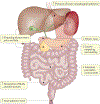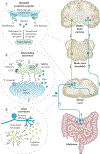Opioid misuse in gastroenterology and non-opioid management of abdominal pain
- PMID: 29139482
- PMCID: PMC6421506
- DOI: 10.1038/nrgastro.2017.141
Opioid misuse in gastroenterology and non-opioid management of abdominal pain
Abstract
Opioids were one of the earliest classes of medications used for pain across a variety of conditions, but morbidity and mortality have been increasingly associated with their chronic use. Despite these negative consequences, chronic opioid use is increasing worldwide, with the USA and Canada having the highest rates. Chronic opioid use for noncancer pain can have particularly negative effects in the gastrointestinal and central nervous systems, including opioid-induced constipation, narcotic bowel syndrome, worsening psychopathology and addiction. This Review summarizes the evidence of opioid misuse in gastroenterology, including the lack of evidence of a benefit from these drugs, as well as the risk of harm and negative consequences of opioid use relative to the brain-gut axis. Guidelines for opioid management and alternative pharmacological and nonpharmacological strategies for pain management in patients with gastrointestinal disorders are also discussed. As chronic pain is complex and involves emotional and social factors, a multimodal approach targeting both pain intensity and quality of life is best.
Conflict of interest statement
Competing interests
E.S. is a consultant for AbbVie and has received royalties from American Psychiatric Association Publishing, grant support from the NIH, the Crohn’s & Colitis Foundation and the Bruce and Cynthia Sherman Foundation, and honoraria for educational talks for Imedex and the American Academy of Child and Adolescent Psychiatry. D.D. is President of the Rome Foundation and has been on advisory boards for Allergan, AstraZeneca, Ironwood and Shionogi in the past year.
Figures



Comment in
-
Opiate deaths demand serious action.Nature. 2017 Nov 30;551(7682):541-542. doi: 10.1038/d41586-017-07657-z. Nature. 2017. PMID: 29189802 No abstract available.
References
-
- Berterame S et al. Use of and barriers to access to opioid analgesics: a worldwide, regional, and national study. Lancet 387, 1644–1656 (2016). - PubMed
-
- University of Wisconsin–Madison Pain & Policy Studies Group. Opioid consumption data Pain & Policy Studies Group; http://www.painpolicy.wisc.edu/opioid-consumption-data (2017).
-
- Ruscitto A, Smith BH & Guthrie B Changes in opioid and other analgesic use 1995–2010: repeated cross-sectional analysis of dispensed prescribing for a large geographical population in Scotland. Eur. J. Pain 19, 59–66 (2015). - PubMed
Publication types
MeSH terms
Substances
Grants and funding
LinkOut - more resources
Full Text Sources
Other Literature Sources
Medical
Research Materials

